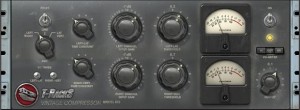Squeeze Play – Compression Demystified
When discussing modern recording techniques, you can’t get far without someone bringing up the topic of compression. If you’ve seen a compressor in the mail-order music catalogs or online music store, but never understood what it was or why you might need it on your recordings, sit tight. The best way to understand compression is to define what it is used for. That being said, compression can be used for one of two primary purposes: controlling dynamics or as an effect.
Controlling Dynamics
When used for controlling dynamics, you can think of compression as manipulating an audio signal to reduce the dynamic range. The dynamic range is the variation between the softest and loudest parts. Reducing the dynamic range through compression makes the softer parts louder and the louder parts softer. This has the overall effect of making the track as a whole seem louder, because you can raise the overall level without causing peaks at an unacceptably high level due to the loudest
transients. Controlling the dynamics of a track is especially important when dealing with signals that have a wide dynamic range.
A good example of using compression for dynamics control would be when recording a Lead Vocal track. Imagine that you’re recording a song that has both some softer vocal parts as well as some louder parts. If you were to set your input level to be fairly hot when recording the softest parts, you would no doubt end up with some clipping when it came to the louder parts. On the other hand, if you set your input level to be fairly hot when recording the loudest parts, the softest parts might end up being almost inaudible. The solution to this problem would be to use a compressor to “tame the peaks” of the
loudest parts, while allowing the softer parts to pass through without being affected, giving a more consistent level throughout the track.
Compression as an Effect
As an effect, compression is used to manipulate, or shape the transients (loudest peaks) of a signal. Although it can be used
on any instrument, this technique is used most often on drums. Compressing drums often has the effect of giving them a fatter, punchier sound. Drums tracks that sound thin, or hollow in their original, unaltered state can usually benefit greatly from compression. Many engineers also describe the effect of compression as making the track seem “closer”, or more in-your-face to the listener.
Compression in Mastering
Compression is not only used in the mixing stage of a recording on individual tracks, but it’s also used in the mastering stage. A mastering engineer will use compression for the same reasons that we’ve already discussed–to control dynamics and as an effect. However, in the mastering stage, this compression is applied to the entire mix (the stereo mix that was created at the mixing stage) rather than an individual track. For this reason, it’s crucial that the engineer apply the compression with extreme care and skill. If not, the entire track can quickly be ruined.
Limiting
When Compression is applied using a Ratio of 10:1 or greater, that compression is usually referred to as “limiting”. Limiting basically sets a ceiling or limit that keeps the level from exceeding that limit under any circumstances. Limiting is especially importing when working with digital audio to prevent the signal from clipping and introducing any unwanted
artifacts such as audible distortion.
The Loudness War
No discussion of compression in mastering would be complete without mentioning what has come to be known as the “loudness war”. This is the term that has come to describe the tendency of modern mixing and mastering engineers to over-compress a recording to try and make it louder than its competition. The idea is that the louder a recording is, the more attention it will demand compared to other “competing” recordings (on TV, radio, etc.). Have you ever noticed that when you’re watching TV, you’ll have the volume set at comfortable level, but then it goes to a commerical break, and suddenly you have to turn
the volume down to keep your ears from bleeding? Well, that’s kind of an appropriate analogy for what we’re talking about here. Commericals are very heavily compressed so that they will be louder than other programs or commericals to grab the attention of the listener more than its competition.
The difference between commercials and recorded music is, with commericals, no one listens to them for the pleasure of it, so if you have to sacrifice the sound quality in exchange for loudness, it’s no big deal. However, when it comes to recorded music, the primary purpose is often for the pleasure of listening to it, so when you sacrifice the quality in exchange for loudness, you have somewhat of a dilemma–just how much quality are you willing to sacrifice? Overly-compressed music also has a tendency to cause listening fatigue, because even if you lower the volume, the music still seems to maintain a consistent higher intensity than comparable music with a wider dynamic range.
Conclusion
In conclusion, compression can be a useful tool in recording audio. It’s helpful both for controlling dynamics and creating effects on individual tracks and on an overall mix. But like all useful tools, you must take care when using it so as not to overuse it. If not used with care, compression can ruin an otherwise great recording.
Further Reading:
http://www.harmony-central.com/Effects/Articles/Compression/
 May 21, 2010
|
Posted by Jon (admin)
May 21, 2010
|
Posted by Jon (admin)


 Categories:
Categories: 